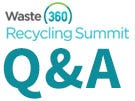Recycling Experts Examine Contamination, Emerging Economies
 This is the fourth part of a series that provide answers by industry experts to questions you have about recycling. The questions came out of Waste360’s recent webinar on the cost of recycling. For further discussion on these issues, don’t miss the Waste360 Recycling Summit in Chicago later this year.
This is the fourth part of a series that provide answers by industry experts to questions you have about recycling. The questions came out of Waste360’s recent webinar on the cost of recycling. For further discussion on these issues, don’t miss the Waste360 Recycling Summit in Chicago later this year.
Read part one here; part two here; part three here.
Question: How do you get residents to care about contamination?
Greg Superneau, education & outreach coordinator, city of Springfield, Mass.: Residents who are recycling, generally speaking, care about their recycling being clean. First identify what is non-recyclable items you are finding the most of in your recycling stream. Next communicate that these items don’t belong in the recycling mix in a simple, direct way to your customers. Effective outreach should include items with pictures and limited text, making it simple to understand.
Michele Nestor, president, Nestor Resources Inc.: I have seen periodic route audits work. The contents of the recycling bin are inspected. Not only are contaminated bins tagged and left behind, but personal contact is made with the resident if they are at home to explain why the recycling was considered contaminated and how to avoid it in the future. Sometimes follow-up calls to those who were not at home are made as well.
Question: Are emerging economies recycling and will their supply of recycled paper continue to push down prices? Is this foreign supply a real risk and if so, how far out in years?
Bill Moore, president, Moore & Associates: Not totally, as new demand for recovered paper will be created by the paper industry in the emerging countries.
Michele Nestor: Not necessarily answering the deeper part of the question, but I would say that the roots of recycling have always been in emerging economies. In fact, scavenging is all about economics. It's entrepreneurship at the purest level. When there is a known market, people who need an income don't have to be coaxed to recover materials. It's the developed countries of the world that recycle for a host of other reasons, not always economics, thus complicating the natural supply/demand model.
Question: What is the best way for material recovery facilities (MRFs) to collect film plastics, and what is the potential outlet for application?
Stephanie Hicks, materials resource coordinator, Trex Co. Inc.: Trex does not recommend film recycling through curbside collections or MRFs. The material is simply too dirty and contaminated for Trex to use in its manufacturing process.
About the Author
You May Also Like


.png?width=300&auto=webp&quality=80&disable=upscale)